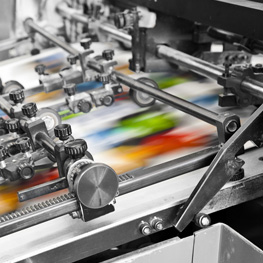
Presses
Presses can accumulate paint, paper, and other contaminants if not cleaned regularly. Manual cleaning such as wiping with kerosene or thinner can be time consuming and ineffective. Printing equipment can be cleaned effectively and in a short period of time with dry ice cleaning. Dry ice blasting is an ideal solution for cleaning all types of printing presses including flexography, offset, and web-fed.
Cleaning Gears & Decks
Ink build-up on the gears and deck guides causes poor alignment and results in low print quality and scrap rates. Today many presses have 6-8 colour decks, and cleaning downtime can easily add up to several thousands of dollars of lost production. However, when using dry ice blasting the cylinders can be removed to provide easy access to all surfaces, and both sides of the deck can be cleaned in as little as 10-15 minutes before going back into production.
General Clean
Dry ice blasting is an effective means of removing wet and dry ink, powder, paper, dust and adhesive residues. Cleaning with dry ice can remove ink, grease, paper lint, and other built-up coatings that can affect registration. This keeps the number of unexpected shutdowns to a minimum, improves product quality and reduces maintenance time.
Dry ice blasting can clean areas around print equipment, hard to reach places and sensitive electrical components that are too difficult to hand clean. Grippers, rollers, drums, ink trays, glue pots, side walls and feeders can all be cleaned using dry ice blast cleaning while presses are online.
Anilox
Dry ice blasting is a great solution to cleaning anilox rolls. The rolls can be cleaned in place without the need for removal. The unique ice splitter nozzle breaks the dry ice pellets down into smaller particles forming a dry ice dust which is able to penetrate the small cells of the Anilox which traditional blasting methods simply cannot achieve.

